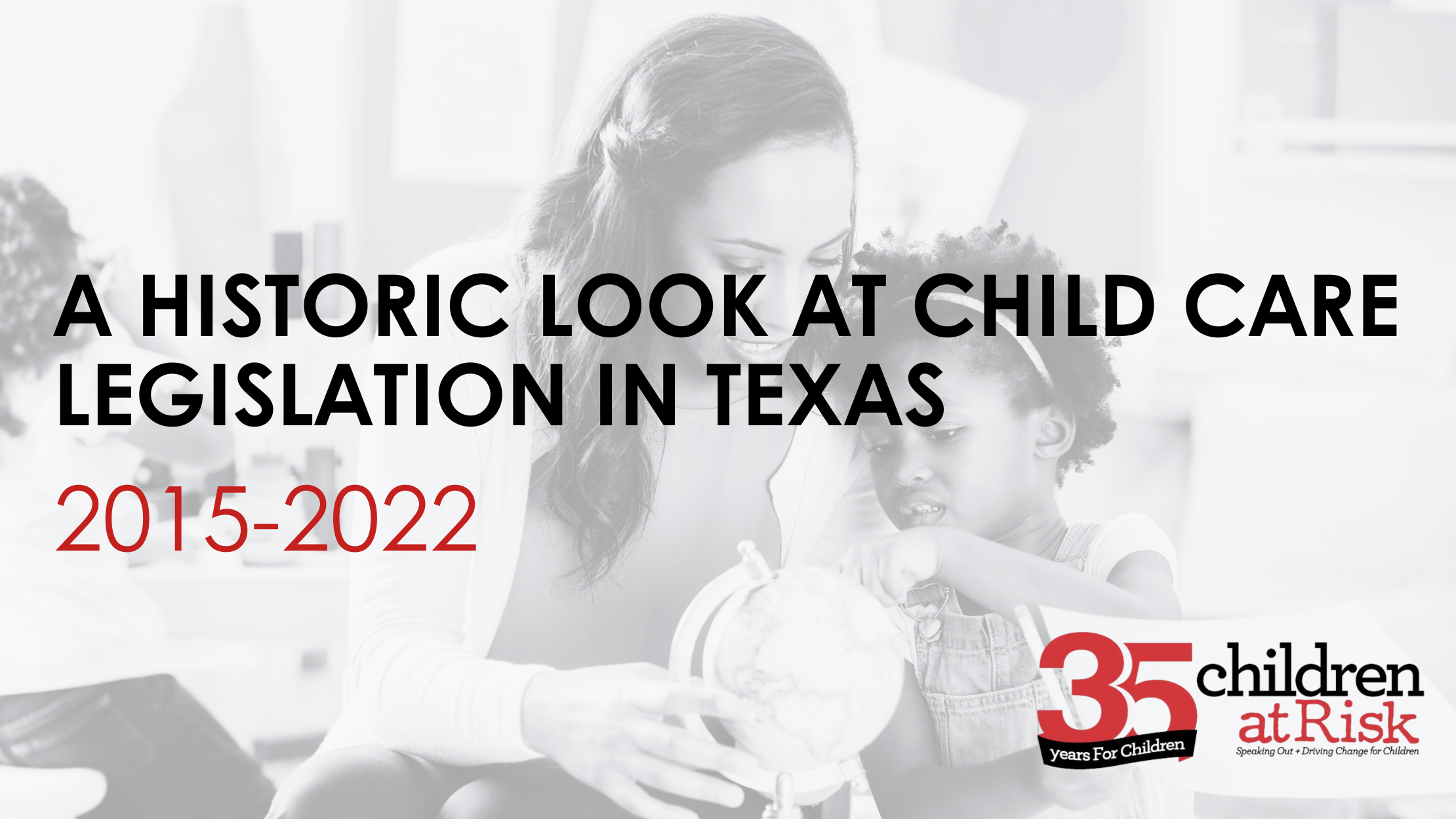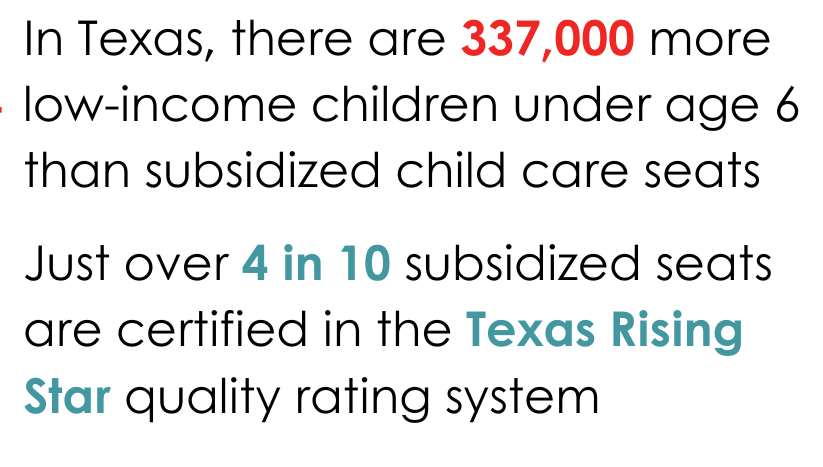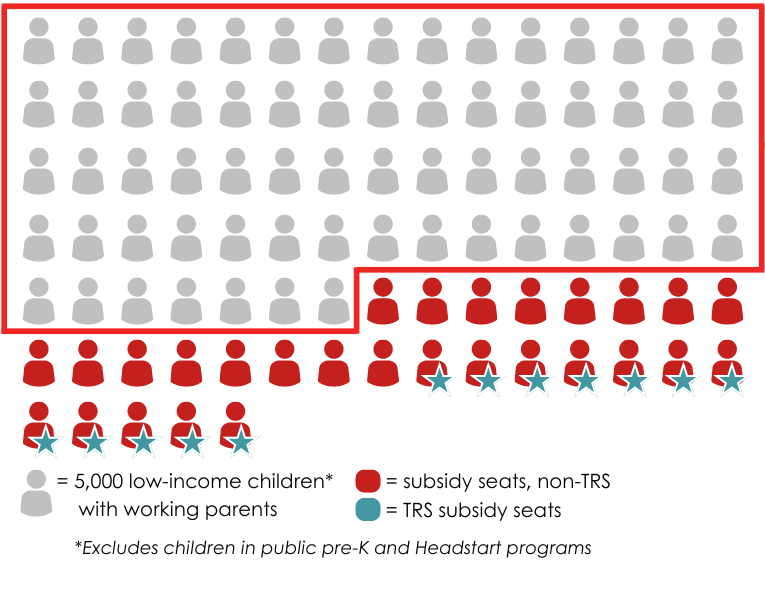
Governor Greg Abbott, Lieutenant Governor Dan Patrick and the Texas Legislature have worked hard for years to improve child care for working parents. Due to smart bipartisan legislation and gubernatorial action in the past decade, Texas now has a more accountable and transparent child care system. Parents and taxpayers can rest assured that money is being invested so that parents can work, and children can succeed in school.
2015 Landmark Legislation | HB4
In 2015, the Texas Legislature passed HB 4, requiring child care programs subsidized by public dollars to provide data on specific metrics using the Early Childhood Information Data System. This legislation drastically improved transparency and the research tools used by the Texas Legislature to monitor and enhance the early education system. HB 4 also requires an annual Early Education Report to be submitted to the Texas Legislature and made publicly available.
2017 Landmark Legislation | SB 2118
In 2017, the Texas Legislature passed legislation to support the quality of child care educators and improve the transparency of publicly funded child care programs and the state agencies that support and monitor them. Child care providers struggle to find well-trained staff. Educators have a hard time accessing quality training that counts toward a college degree.
SB 2118 allows more community colleges to offer baccalaureate programs in early childhood education.
2019 Landmark Legislation | HB 680, HB 3, SB 708
In 2019, three important bills passed. The landmark HB 680 improves the transparency of hundreds of millions of mostly federal dollars that Texas spends on child care scholarships for low-income working families through the Texas Workforce Commission (TWC). HB 680 requires TWC to report data on its federal Child Care Subsidies program. Previously, TWC did not have to report data related to the quality and accountability of the agency’s federally-funded child care program for working parents. This bill finally provides Texas with data to evaluate state spending on child care.
HB 3 defined and required quality in pre-K partnerships between school districts and child care programs.
SB 708 mandated the Texas Health & Human Services Commission to publish an annual report detailing reported incidents at licensed child care centers that involve threats to a child’s health, safety, or wellbeing.
2021 Landmark Legislation | HB 2607, HB 619
With all these newly available data, Texas, in 2021, made huge strides to further improve the quality of taxpayer-funded child care to support low-income working parents. For the first time, the State of Texas demanded quality for its money.
HB 2607 created a new requirement that all child care providers that accept government funding must participate in the state’s quality-rated Texas Rising Star program.
Recognizing that employers struggle to recruit and retain employees because of a lack of child care workers, the Texas Legislature passed HB 619. This bill requires TWC to develop a strategic plan to improve the child care workforce. The strategic plan is another tool of accountability and transparency for the Texas Legislature to better understand how Texas is spending taxpayer money.
2023 Landmark Legislation | SB 1145/SJR 64, HB 1615, HB 1905
In 2023, Texas Legislature passed three bills to increase accountability and efficiency. And, for the first time in history, Texans voted to pass a constitutional amendment in support of child care.
SB 1145/SJR 64 maximizes existing funds available to child care programs by providing property tax relief for child care providers serving low-income children. This legislation was brought before Texans as Proposition 2 in the 2023 election, and voters approved it by 65%.
HB 1615 increases accountability by requiring one member of each Local Workforce Board to be a person with expertise in child care. Local Workforce Boards are responsible for providing training and support to child care providers in their communities, and HB 1615 ensures that child care is well represented during board discussions.
HB 1905 also increased efficiency by allowing school districts to provide school safety training courses to child care programs in their communities.
In the last 10 years, bold leadership has created a foundation of transparency, quality, and efficiency for child care in Texas, and we look forward to more progress, especially in accessing child care. Some 333 communities in the state are considered “child care deserts,” meaning demand for child care is three times greater than the supply. Only 1 in 5 low-income working families have access to subsidized child care. Almost 100,000 working parents are on the waiting list for child care scholarships, and roughly 200,000 more working parents are eligible but do not apply.
To continue making progress and growing the economy, Texas should continue to maximize existing resources and invest new and sustainable state funds into child care.


CHILDREN AT RISK proposes these steps in 2025:
Maximize all existing state and federal resources. Currently, Texas only spends the minimum funds necessary to draw down federal dollars. Any surplus federal dollars, such as funds from Temporary Assistance for Needy Families, that can be used to support working parents, should be used to increase workforce productivity. Texas can also take steps to improve coordination between employers and providers hoping to expand their services.
Create a new and sustainable revenue source for child care. Texas has options for creating new revenue for child care. Texas could follow the lead of Louisiana and dedicate a portion of potential gaming revenue to expand child care access for working parents. Texas could also look to expand taxes on nicotine, alcohol, oil and gas production, or other products to reduce waiting lists for low-income working families, to reimburse child care providers at the established state rates, or to provide funds to Local Workforce Development Boards funds to develop and implement recruitment and retention strategies.
Support Family Child Care providers. Texas lost nearly 32% of Family Child Care (FCC) providers since March 2020. While child care centers have returned to pre-pandemic levels, FCC programs have not. FCC offers parents a smaller environment, since these programs are in someone’s home and serve fewer children. FCCs are more likely to offer care for parents who work non-traditional schedules and need overnight child care. Texas can build the supply of FCC providers, especially in child care deserts and in rural communities.